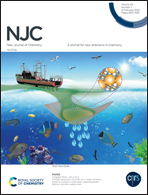Reactivity of hemi-labile pyridyl and pyrimidyl derived chalcogen ligands towards group 10 metal phosphine precursors
Abstract
A drive to understand the reactivity of hemi-labile organoselenide and telluride ligand systems has made this area of research increasingly popular. For this purpose, various metal systems have been applied. Among them, group 10 metal precursors have been exploited predominantly because the resulting complexes are important as catalytic, semiconductor and supercapacitor materials. The wide applicability of these compounds has driven us to explore the chemistry of N-heterocyclic-based ligand systems. Overall, this research deals with the reactivity of N-heterocyclic dichalcogenides Ar2E2 (Ar = C5H4N, C5H3(3-Me)N, C4H3N2, C4H(4,6-Me)N2; E = Se, Te) and their sodium salts (generated by the reductive cleavage of E–E bonds through NaBH4) towards group 10 metal phosphine precursors via oxidative addition and substitution routes. The oxidative addition reactions of [M(P-P)2] (M = Pd, Pt) and substitution reactions of [MCl2(P-P)] (M = Ni, Pd, Pt) with diorgano dichalcogenide and sodium salts of N-heterocyclic selenolate ligands afforded exclusively mononuclear compounds [M(SeAr)2(P-P)] (M = Ni, Pd, Pt; Ar = C5H4N, C5H3(3-Me)N, C4H3N2, C4H(4,6-Me)N2; P-P = dppe, dppp, dppf), however the pyrimidyl selenolate-derived mononuclear compounds transformed to trinuclear products after prolonged standing in chlorinated solvents. In contrast to the selenium analogues, all probable mono to tri nuclear complexes of tellurium were isolated depending upon the metal and phosphine, and the nature of the solvent. The isolation of various products depended on the comparable bond dissociation energies of the Te–Te and Te–C bonds. Among these, a ferrrocenyl auxiliary phosphine ligand-based mononuclear tellurolate compound [Pd(TeC5H4N)2(dppf)] was used for H2S gas sensor applications. The efficiency of a thin film of this compound was 75% with a sensitivity of down to 5 ppm at room temperature.

- This article is part of the themed collections: 2020 Focus and Perspective articles and Selenium & Tellurium chemistry at the beginning of the 3rd millennium: a celebration of ICCST


 Please wait while we load your content...
Please wait while we load your content...